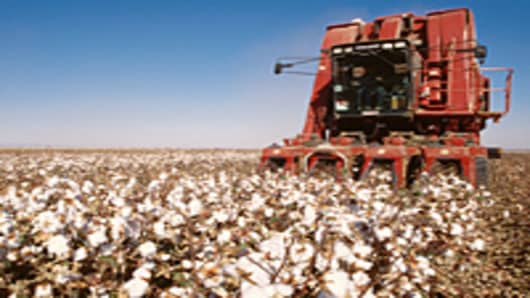There's been so much talk about rising commodity prices that we decided to pick one that isn't front-page news like oil and gold, yet could have a significant impact on the consumer and investors.
How about cotton.
It's at pricing levels not seen since just after the Civil War, spiking about 80 percent since the early summer. Considering that just about everyone wears a lot of it every day, we traveled to the cotton heartland of Tennessee to get more insight.
"It's really been amazing," said Howell Moore, who runs a cotton-growing and gin operation in Sommerville, Tenn. "We haven't seen anything like this. I have seen it take a couple of runs before in my life, but nothing like this. It doesn't seem to have an end to it."
Moore says most growers haven't capitalized on the rally up to the $1.30-a-pound range, since most 2010 pricing was locked in well in advance. However, if prices remain high, that will change.
"I think we will have good prices going forward," he said. "I think it will be close to a dollar—92 cents to a dollar—but I don't think we'll see these prices (very) long."
Analysts say several factors are involved in this historic move, and the macro picture for cotton is more complex than a simple weak dollar, strong commodity play. Global demand is up, supply is extremely tight, and weather has been a major factor all across the globe.
"It seems that all the fundamentals are bullish from Texas storms late last week to China weather to Pakistan import issues—and India the same," said Roger Corrado of Spectron Commodity Futures. "Everything just points to high prices in cotton, and it's basically unchartered territory."
As for when the commodity market pricing will translate into higher retail prices, that's unchartered territory as well. Companies like Hanesbrands, which reports earnings on Wednesday, have come into focus since so many of its products are entirely derived from cotton.
"Late spring and into the fall of next year, you are going to price increases not just from companies like Hanes and brands like Hanes, but kind of throughout the industry," said Omar Saad, Credit Suisse's Apparel and Footwear analyst.
That's a significant lag time, but in terms of potential inflation harbingers, this could be a clear one. And although it might be stating the obvious, a lot of cotton goes into products used by every single human on earth, every day—ranging from t-shirts to blue jeans.
In fact, here are some interesting numbers about what is made from a bale of cotton (approximately 500 pounds), courtesy of the National Cotton Council of America. A bale produces 215 pairs of jeans. The rectangle mass of cotton can also be used for 249 bed sheets, 2,104 pairs of boxer shorts, 1,217 t-shirts or 765 men's dress shirts.
From the numbers, it certainly seems like the price of your new jeans is about to go up.
"The large companies with scale in their manufacturing, who have a very diversified vendor base and supply chain, are going to be able to manage through this much better than small companies that have a concentrated supply base who don't have a lot of negotiating power, who don't have a lot of leverage with the supply chain," Saad says.
Most analysts also tell CNBC that retailers and manufacturers may attempt to pass along costs a lot sooner in order to protect margins and corporate profits. Much like the impact of impending food inflation reported by the USDA earlier this week, rising costs will either be absorbed by consumers in the form of higher prices, or absorbed by shareholders in the form of lower profits.


